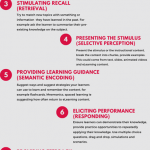Introduction
The Gagnes model, developed by Maria Gagnés in the early 1990s, is one of the most popular and widely used educational models today. The Gagnés model provides educators with a set of tools that can be used to design and evaluate educational programs and interventions.
A guide to Gagné’s Nine Events of Instruction is thorough and comprehensive; it describes well the nine steps for teaching skills as well as a variety of classroom activities to help teachers introduce, review, practice, and apply specific skills in the classroom.
Gagné’s Nine Events of Instruction (GEM) Model identifies nine events that occur throughout the learning process and provides guidance in planning effective instruction. It provides a roadmap for instructional planning, identifying critical milestones that need to be accomplished at each stage of learning. The model also helps identify the necessary steps in the learning process that need to be addressed during instruction.

Gaining attention is the first step in the process of teaching a skill or concept. The teacher has to capture the student’s attention and interest and provide a foundation for their learning experience. This can be done in a variety of ways, including providing relevant examples that relate to the student’s personal experiences, creating interesting stories, asking questions, using humor, and giving clear instructions. Once attention has been gained, the teacher can move on to getting students to participate in the learning process.
Informing learners of the objective (expectancy) is the second step of Gagné’s Nine Events of Instruction. It involves providing a definition of the skill to be taught, as well as the reason for learning it.
Stimulating recall of prior learning (retrieval) is the third step. This step involves prompting students to think about past learning experiences in which they have acquired a similar skill or mastered the same concept.
Presenting the content (selective perception) is the fourth step. During this stage, the teacher presents a visual display of information to stimulate mental activity and help the learner assimilate and retain the information being presented. For example, when introducing a new skill such as making a pizza, a teacher could display pictures of the ingredients to be used and have each student say the name of the ingredient as it is identified.
Providing learning guidance (semantic encoding) is the fifth step. It involves the teacher assisting the student in coming up with the best way to organise and store the information being learned. For example, when the teacher is teaching a child how to tie her shoes, she might prompt the child to think about how she would keep track of all the laces so that the shoe could be put together correctly the next time she puts on her shoes.
Eliciting performance (responding) is the sixth step. In this step, the teacher encourages students to perform tasks on their own under the guidance of the teacher. The teacher may provide feedback about the student’s performance to help him or her improve the skill being learned.
Providing feedback (reinforcement) is the seventh step. This involves offering positive encouragement about the performance of the learner and critiquing areas that can be improved. For example, a teacher can give a student positive feedback for completing math problems accurately and provide feedback on how to improve in areas where he or she did poorly.
Assessing performance (retrieval) is the eighth step. It involves gathering information about the student’s performance in order to identify areas in need of improvement. This helps the teacher determine which teaching methods and techniques were most effective at promoting learning and to plan future lessons accordingly. For example, a teacher could ask students to complete a specific task and then give them feedback on their performance.
Enhancing retention and transfer (generalisation) is the ninth step. This involves helping students use newly acquired skills in many different situations in order to further develop cognitive skills and foster lifelong learning. For example, a teacher might involve students in a project to design and create toys for children in a hospital who are undergoing medical treatments.


